 |
Feeling lucky?
Want to
search
any of my partnershops yourself
for more, better results?
(commissions earned) |
The links below
will take you
just there!!!
|
|
 |
Within the Italian film industry, and no matter in which genre, Antonio
Magheriti a.k.a. Anthony M.Dawson was always considered being more than
anything else a craftsman. Essentially, this label is correct, since he
was never a horror visionary like Riccardo Freda or Mario Bava [Mario
Bava bio - click here] in the
1960's or Dario Argento in the 1970's, and neither did his horror flicks pack
the same punch as Lucio Fulci's shockers in the early 1980's [Lucio
Fulci bio - click here]. Also his Westerns
were never on par with Sergio Leone's output (with one possible
exception), his action films would not feature the same elegant setpieces
as Enzo G.Castellari's best films [Enzo
G.Castellari bio - click here], and his sex films (he made very few of
these) never received the same cult following as Joe D'Amato's [Joe
D'Amato bio - click here]. However,
Antonio Margheriti was quite probably the best craftsman Italian cinema
ever had, no matter what genre he worked in, he always put a good amount
of care into his films, and thus, even his worst movies were never quite
as embarassing as comparable ones by other directors out for a quick buck. Also,
thanks to his versatility, Margheriti would work during his almost 40
years-long career, work in almost every genre, and his filmography does
(in retrospect) perfectly mirror the history of Italian cinema from 1960
onwards. Antonio Margheriti entered the film world in the
1950's, when the Italian film industry hit a new highwith all sorts of
productions - and consequently, Margheriti could be seen in all sorts of
functions in the following years, among them editor, scriptwriter and -
perhaps most important for his later career - special effects wizard. (In
later days, when he was already sitting firmly in the director's seat, he
would a few times go back to doing just special effects, for Stanley
Kubrick's 2001 - A Space Odyssey [1968] - though he claimed in an
interview that his involvement was minimal -, for Sergio Leone's Giù
la Testa/A Fistful of Dynamite [1970] and for Aldo Lado's L'Umanoide/The
Humanoid [1978].)
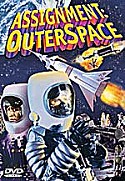
 Flix.com Flix.com
|
| |
Antonio Margheriti's
debut as a director came in 1960,
with the film Space Men/Assignment: Outer Space, a space
opera. Now science fiction in general was a genre new to the Italian film
industry in 1960, so the film's production companies Ultra Film and Titanus
did
not trust the film completely, especially since it was done by a
first-time-director, and thus granted Margheriti a miniscule budget of
around $ 30,000 and less than 20 days for shooting. It was thanks to
Margheriti's previous experiences in the film industry, especially
concerning special and miniature effects (which he always loved) that the
film turned out quite ok (always keeping in mind budgetary and temporal
restrictions). Actually, the film even sold to British and
American producers ... which forced Margheriti to assume a new, anglizised
name - to make the film seem like an American production (by the way a
quite common practice in Italian cinema). His first choice was Anthony
Daisies, a direct translation of his name, but the distributors didn't
like it (probably because it sounded a bit gay), so he became
Anthony Dawson (and later Anthony M. Dawson), a name that would
stick with him throughout his career.
Space Men
proved
to be successful enough for the Italians to believe into the sci-fi-genre,
and to entrust Margheriti with another film, Il Pianeta degli Uomini
Spenti/Battle
of the Worlds/Guerre Planetari in 1961. This time, Margheriti
had a higher budget at his disposal, and with Claude Rains in the lead, he
even had an American name actor to star in the film. With
his 3rd film, La Freccia d'Oro/The Golden Arrow (1962),
Margheriti's career saw an early high, as it was co-produced by Italian Titanus
and American MGM.
The resulting film however is not nearly as exciting as this collaboration
may sound, a mediocre Arabian fantasy starring Tab Hunter, featuring a
run-of-the-mill plot and special effects ranging from great to so-so.
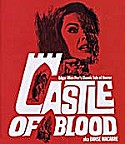
 Flix.com Flix.com
|
| |
On
a pure quality level, Margheriti's next film, Danza
Macabre/Castle of
Blood (1963) is of much more interest, a dark and atmospheric
horror tale about a man (Georges Rivière) spending
a night in a haunted castle to win a bet, not believing in ghosts - only
to in the very end fall victim to them. Barbara Steele [Barbara
Steele bio - click here], (relatively) fresh
from Mario Bava's [Mario Bava
bio - click here] groundbreaking La
Maschera del Demonio/Black
Sunday (1960) and Roger Corman's [Roger
Corman bio - click here] Edgar Allan Poe adaptation The Pit
and the Pendulum (1961) - which explains the Poe-angle of Castle of
Blood -, stars in this one.
Actually, the film was to be directed
by Sergio Corbucci, who had to abandon the project in the last minute to
do another film, so on extremely short notice, Margheriti was hired ...
and despite the fact that he had virtually no time to prepare the film and
the shooting schedule was particularly hurried (about two weeks), the film
turned out to be his first minor masterpiece, a diligently directed, creepy
Gothic that looked much better than its humble origins.
That
same year, Margheriti would return to the world of Gothics with La
Vergine di Norimberga/The
Virgin of Nuremberg (1963) starring Christopher Lee. Actually, the
film was supposed to be set in modern times (and has a post-World War II
subplot), but on an aesthetic level, Margheriti decided to have it look
like a genuine Gothic, which works quite alright within the horror genre,
naturally.
In 1964, Margheriti would make yet another horror
film, I Lunghi Capelli della Morte/The Long Hair of Death,
again starring Barbara Steele, but soon enough, he was all
over the place, genre-wise, trying to do his best in whatever genre thrown
at him and doing his films in a rapid succession:
He did peplums (Il Crollo di
Roma/The
Fault of Rome [1963], Anthar L'Invincibile/The Slave Merchants [1964],
Ursus il Terrore del Kirghisi/Hercules,
Prisoner of Evil [1964, this one was actually co-directed by an
uncredited Ruggero Deodato - Ruggero
Deodato bio - click here], I Giganti di Roma/The Giants of Rome [1964]), science
fiction (I Criminali della Galassia/Wild
Wild Planet [1965], I Diafanoidi vengono da Marte/War of the Planets
[1965], Il Pianeta
Errante/War Between the
Planets/Planet on the Prowl [1965], La Morte viene dal Pianeta
Aytin/Snow
Devils [1965]), espionage flicks (A077 sfida ai Killer/Killers
are Challenged [1965], Operazione Goldman/Lightning
Bolt [1966]), Westerns (Joe l'Implacabile/Dynamite
Joe [1967], Joko, invoca Dio... e Muori/Vengeance [1968]), a giallo (Nude... si
Muore/Naked You Die/Schoolgirl
Killer [1968]) and whatever else there was. And as if that
wasn't enough, towards the end of the 1960's, Margheriti also launched his
own (short-lived) production company, Edo Cinematografica, named
after his son Edoardo. The company only produced two films though:
The first, Contranatura/The Unaturals (1969) was a weird horror film co-produced
with Super International Productions and German CCC
Filmkunst. Those who have seen this rather obscure film rank it
among Margheriti's best (horror-)films. The second film by Edo
Cinematografica was L'inafferrabile, invincibile Mr Invisibile/Mister
Superinvisible
(1970), a film very much in the style of Disney-family comedies like The
Absent-Minded Professor or The Shaggy Dog. The film did alright
on the international film market, but since Margheriti wasn't nearly as
good a businessman as he was a filmmaker, he still lost money on it ...
and that was the end of Edo
Cinematografica.
Around the time he did these two films,
Antonio Margheriti also made the film that is possibly his masterpiece
(even though it is to that day gravely underappreciated by critics and
filmfans alike): E Dio
Disse a Caino/And
God Said to Cain (1969), a very unusual Spaghetti Western that
takes the run-of-the-mill vengeance plot and turns it into something more
closely resembling Gothic horror than anything else, with Klaus Kinski,
the perennial Spaghetti Western bad guy, playing the hero for a change,
and chillingly so. This film, though by far not as recognized, ranks
right up there with the best of them, like Once Upon a Time in the West,
Django or Keoma,
and if in your life you only want to see one Antonio Magheriti-film, this
one definitely should be it.
| 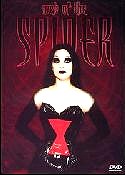
 Flix.com Flix.com
|
|
In 1971, Antonio Margheriti got
another chance to work with Klaus Kinski, on Nella
Stretta Morsa del Ragno/Web of the Spider,
which was basically a remake of Margheriti's earlier Danza
Macabre/Castle of
Blood, showing Kinksi only in a supporting role as Edgar Allan
Poe. The film was merely a good, old-fashioned (and of course well-made)
horror show, no more, but certainly no less.
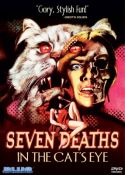
 Flix.com Flix.com
|
| |
The same can be said of La
Morte negli Occhi del Gatto/Seven Dead in the Cat's Eye (1973),
a nice old-fashioned shocker starring Jane Birkin. In between,
Margheriti was forced to do a string of unremarkable films, like his two
excursions into erotica, Novelle Galeotte d'Amore del Decamerone/Erotic
Novels of Decameron and Finalmente ... Le Mille e una Notte/1001
Nights of Pleasure (both 1972, both rip-offs of rrespective Pier Paolo
Passolini-films) or the pointless martial arts comedy Ming, Ragazzi/Hercules
vs Karate (1973), which, if anything, proved that neither erotica nor
comedy were Margheriti's forte.
| 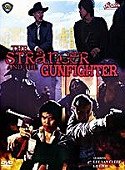
 Flix.com Flix.com
|
|
Of more interest (at least on
paper) might be two Westerns he made around the same time: One was La
Dove non Batte Il Sole/Blood Money/The Stranger and the
Gunfighter (1974) was an Italian co-production with legendary Hong
Kong producers the Shaw
Brothers and was an attempt to blend the Western and the Eastern
genre, starring Lo Lieh as a fighter from the East visiting the old West
and Lee Van Cleef as a born Westerner. The other film was Take a Hard
Ride (1975), an American production by 20th
Century Fox which was an attempt to blend the Western and the
blaxploitation flick, to breathe new life in the then waning
blaxploitation genre (and still make a few bucks out of it). Consequently,
the film stars blaxploitation icons Jim Brown, Fred Williamson and Jim
Kelly (besides Lee Van Cleef as an evil white man). Both this films were
well enough made as far as craftsmanship goes (and one wouldn't expect any
less from Antonio Margheriti), and both films have attained a certain cult
status over the years ... but at the same time, neither film was great in
the true sense of the word, and neither could be called a classic.
|
|
 |
|
|
 |
|
|
Margheriti's
contribution for two films in 1974, the Andy Warhol/Carlo
Ponti-co-productions Carne
per Frankenstein/Il Mostro e in Tavola ... Barone Frankenstein/Flesh
for Frankenstein and Dracula cerca Sangue di Vergine e ... Mori di
Sete/Blood for Dracula, will perhaps remain forever uncertain.
Officially, Andy Warhol house-director Paul Morrissey is credited as the
sole director, but due to the fact that Margheriti was involved
(whatever that means) in making the film and the film looks much more
polished than Morrissey's earlier work (e.g. Trash, Flesh, Heat)
has made many people (none of whom, mind you, were actually involved with
the shoot) that it was actually Margheriti who directed the films -
womething Marheriti never claimed he did bjut in interviews even he was a
bit cryptic about it.
If you want to hear my 2 cents about the whole
affair (and I freely admit that's only my opinion, based on mainly
guesswork): The two films do totally have the feel of Morrissey's earlier
work (withthe one difference that they are horror films) for Andy Warhol
while having very little in common with Margheriti's earlier horror
flicks, so I see very little doubt about who these films should be
attributed to. However, the films also show an attention to detail not
found in Morrissey's earlier work as well as some goodlooking special
effects - which would suggest that Antonio Margheriti was a very dilligent
assistant or second unit director on both films ... but as I said, this is
only guesswork ...
The rest of the 1970's, Margheriti made a
few more action films, the crime thrillers Con la Rabbia agli Occhi/Death
Rage (1976) - starring Yul Brynner and Barbara Bouchet - and Controrapino/The
Rip-Off/The Squeeze (1977) - starring Lee Van Cleef, Karen
Black and Lionel Stander -, and the adventure thriller Killer
Fish - Agguato sul Fondo/Killer Fish (1977), which was marketed as a
sequel to Joe Dante's Piranha (1978) in several regions of the
world - even if it was filmed a year earlier ! This one by the way starred
Lee Majors, fresh from his success with the TV-series The Six
Million Dollar Man. All these films were as well-made as one would
come to expect from Antonio Margheriti ... however, none of them was
anything great or memorable.
Then, in 1980, Margheriti made one
of his most notorious films, though not necessarily one of his best, Apocalisse
Domani/Cannibal
Apocalypse, a film of a bunch of Vietnam veterans led by John
Saxon [John Saxon bio - click
here], who back at home turn into cannibals.
Made in the wake of anti-war
films like Deer Hunter and Apocalypse Now - both also
dealing with the Vietnam war - Cannibal
Apocalypse could have been a bold anti-war statement, and
it even shows some thought-provoking elements, but the producers (not
Margheriti, by the way) wanted to focus on gore effects rather than big
concepts to be able to sell the movie - and from a
businessman-point-of-view the producers were possibly right, because
selling the film did, and even nowadays, it is re-issued on DVD every few
years and is raved about in some fan publications.
In 1980,
Antonio Margheriti also made his first bona fide war film, L'Ultimo
Cacciatore/The
Last Hunter, another film in which some thought-provoking concepts
are overshadowed by action and gore effects. However, even if this film
falls short of its possibilities on an intellectual level, it proves
Margheriti's excellent craftsmnanship concerning action and model work,
and his trademark attention to detail does give the film a certain
polished look not betraying the rather meager budget it was made on.
Based
on his brilliant work on The
Last Hunter, Margheriti soon got offers for doing more and more
war and mercenary films, which were the rave in the early- to mid-1980's,
thanks to the success of above-mentioned Deer Hunter and Apocalypse
Now and of course the successful Rambo-series.

 Flix.com Flix.com
|
| |
| 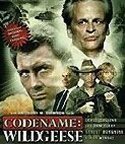
 Flix.com Flix.com
|
|
Margheriti's war
films, usually shot in the Phillipines - where Margheriti during that time
filmed a lot -, included Fuga dall'Arcipelago
Maledetto/Tiger Joe (1981), Tornado/The Last Blood
(1983), and the Mercenary
Trilogy starring Lewis Collins he made for producer Erwin C.Dietrich's Ascot Film, Arcobaleno
Selvaggio - Wild Geese/Codename
Wild Geese (1984), Commando Leopard (1985) and Der
Commander/The Commander (1987). Codename
Wild Geese and Commando Leopard also starred Klaus Kinski
in a supporting role.
Also in 1980 came Car
Crash, one of Margheriti's most pointless films, a car
crash-comedy (hence the title) starring Joey Travolta (John Travolta's
little brother) made to cash in on the success of films like the Smokie
and the Bandit-movies.
By and large, in the 1980's the Italian film
industry saw its downfall: Due to a predominance of Hollywood movies at
the box office, no one was willing anymore to spend money on original but
risky films, instead the industry found itself ripping off every succesful
Hollywood (formula-)movie and squeeze a few bucks out of every film trend
before it could die down. Formula films like the Star Wars-series, the
Conan-series,
the Indiana Jones-series and the Alien-series
were all popular blueprints for Italian moviemakers during that time -
but of course, generally the budgets of the Italian rip-offs didn't even
come close to those of the American originals, and it often shows. Margheriti
did make his fair share of rip-offs during the 1980's, and when his films
were a cut above the rest, that's only thanks to his excellent
craftmanship, and his experience with (cheap) special effects.
Based
on the Indiana Jones-series, Margheriti made a series of
rather forgettable adventure movies, including I Cacciatori del Cobra
d'Oro/Hunters of the Golden Cobra (1983), I Sopravvissuti della
Città Morta/The Ark of the Sun God (1984), and La Leggenda
del Rubino Malese/Jungle Raiders (1985), while the Alien-series
inspired the rather trashy and unintentionally funny Alien
degli Abissi/Alien
from the Deep (1989).
Antonio Margheriti's funniest rip-off-film
though was the Italian-Turkish co-production Il Mondo di Yor/Yor,
the Hunter from the Future (1982), a film where he manages to
include elements from both the Star Wars-series and the
Conan-series
and cook it up to a wonderfully trashy potpourri tht has to be seen to be
believed - but be warned, watch it with beer
For Italian
TV-station RAI,
Antonio Margheriti made a miniseries that was once again somehow based on
the Star Wars series (at least inasmuch as it was a space
opera) in 1986: L'Isola del Tesoro/Treasure Island/Space
Pirates. This series took the basic plot of Robert Louis Stevenson's
classic Treasure Island and transposed into a sci-fi setting. The
film featured an interesting mix of Italian and international actors -
like David Warbeck, Anthony Quinn, Ernest Borgnine, Giovanni Lombardo
Radice, Al Yamanouchi and Sal Borgese - and special effects ranging from
the apparently dirt-cheap to the quite impressive. Interestingly,
in 2002, Walt Disney Productions picked up the idea of a sci-fi
retelling of Treasure Island, this time as an animated movie called
Treasure Planet (directed by Ron Clements, John Musker) ... on that note
though, it also has to be mentioned that Treasure Island has to be turned
into a space opera even sooner than Margheriti's series, with the 1982
Bulgarian animated film Planetata na sakrovishtata/Treasure
Planet, directed by Rumen Petkov ...

 Flix.com Flix.com
|
| |
By the end of
the 1980's, the Italian film industry was in its death throws, and films
like Indio, which he made in
1989, show it. Indio was
actually a thinly disguised rip-off of the Rambo series with
an ecological message tagged on, starring Francesco Quinn (Anthony Quinn's
son), boxer Marvelous Marvin Hagler, alongside Rambo-veteran
Brian Dennehy (from First Blood). In 1990, Indio
even got a
sequel, Indio 2 - La Rivolta/Indio 2 - The Revolt, with this
time Marvelous Marvin Hagler taking the leave and Jack Napier from Rambo
- First Blood Part 2 as his nemesis. Both these films were once
again competently made, with decent action scenes and special/miniature
effects, and looked better than most comparable films from that time
populating the shelves of your local video rental ... but at the same
time, they just were nothing special, either, just run-of-the-mill
action. The
1990's, with the Italian film industry having died down, offered little
opportunities for even an accomplished director like Antonio Margheriti:
In 1992, he co-directed the miniseries Genghis Khan with Ken
Annakin, but Annakin received sole directing credit - and then the whole
thing wasn't released until 2004.
The only other film Margheriti made in
the 1990's was Potenza Virtuale/Virtual Weapon, a cop comedy
starring Terence Hill and once again Marvelous Marvin Hagler scripted by Bruno Corbucci. The film looked
like a
desperate attempt to recapture Terence Hill's comedy-successes from the
1970's - and sadly enough, Terence Hill's comedy didn't work any more in
1996. The film was below the standard of both Antonio Margheriti and
Terence Hill. Virtual Weapon would remain Antonio
Margheriti's last film ever, he died from a heart attack in 2002. His legacy however
will live on, a bunch of well-crafted films in every genre the Italian
film industry touched from the 1960's to the 1980's, some of them (let's
face it) simply bad, some hokey but fun, but many of them very decent
genre pics ... and some of them even masterpieces.
|